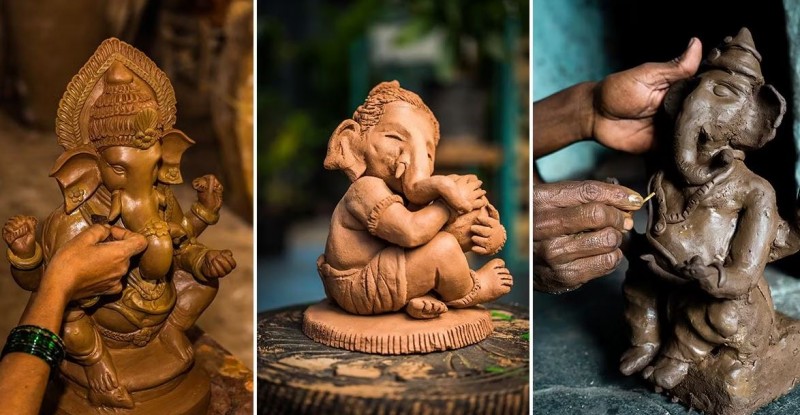
Ganesh Chaturthi is a vibrant and joyous festival celebrated with great enthusiasm. Traditionally, this festival involves installing Ganesh idols in homes and public spaces, followed by elaborate decorations, rituals, and ultimately, the immersion of the idols. However, with growing environmental awareness, many people are turning to eco-friendly alternatives to traditional plaster of Paris (POP) idols, which can be harmful to water bodies. This article explores various eco-friendly materials you can use to create Ganpati idols at home.
Why Choose Eco-Friendly Ganpati Idols?
Traditional Ganesh idols made from plaster of Paris are not biodegradable and can pollute water bodies when immersed. Eco-friendly idols, on the other hand, are made from natural materials that dissolve easily in water and do not harm the environment. By opting for these sustainable options, you can celebrate the festival while minimizing your ecological footprint.
Materials for Eco-Friendly Ganpati Idols
Clay (Mitti)
Why Clay? Clay is a natural material that is easily available and completely biodegradable. It is one of the most popular choices for eco-friendly Ganpati idols.
How to Use: To make a clay Ganpati idol, knead the clay with water until it reaches a workable consistency. Shape it into the desired form, including the body, head, and limbs. Allow the idol to dry naturally before decorating it with natural colors or decorations.
Cow Dung (Goobar)
Why Cow Dung? Cow dung is an excellent eco-friendly material that is both sustainable and biodegradable. It has been used traditionally in many cultures for making various items.
How to Use: Mix cow dung with a little water to form a workable paste. Shape it into the Ganpati form and let it dry. Once dry, you can paint or decorate it with natural materials.
Turmeric (Haldi)
Why Turmeric? Turmeric is a natural, organic material that can be used to create simple yet effective Ganpati idols. It is also known for its vibrant yellow color and easy workability.
How to Use: Grind turmeric into a fine powder and mix it with water to form a paste. Use this paste to mold the Ganpati idol. Once shaped, allow it to dry completely.
Flour (Maida)
Why Flour? Flour can be used to create a dough-like substance that is easy to shape and mold. It is also biodegradable and can be a practical alternative for making Ganpati idols.
How to Use: Mix flour with water to form a dough. Shape the dough into the Ganpati form and let it dry. Once dry, you can paint it with natural colors or decorate it using other eco-friendly materials.
Sago (Sabudana) and Rice
Why Sago and Rice? These materials can be used for decorating the idols, adding texture, and providing a unique look.
How to Use: Cook sago and mix it with other decorative items such as colored rice, pulses, or natural beads. Use these to adorn the Ganpati idol, adding both texture and color.
Steps to Make an Eco-Friendly Ganpati Idol
Preparation:
Gather all the materials you will need, including the chosen base material (clay, cow dung, turmeric, flour) and decorating items (sago, rice, natural paints).
Creating the Base:
Prepare your chosen material by mixing it with water to achieve a workable consistency. Shape the material into the Ganpati form, including the head, body, arms, and trunk.
Drying:
Allow the shaped idol to dry completely. This may take a few hours to a couple of days, depending on the material used and the size of the idol.
Decorating:
Once dry, decorate the idol using natural paints, colored rice, sago, and other eco-friendly items. You can also use natural elements like flowers and leaves for additional embellishments.
Final Touches:
Ensure the idol is completely dry and ready for the festival. If necessary, make any final adjustments or touch-ups to the decoration.
Immersion:
During the immersion process, the eco-friendly idol will dissolve naturally in water, causing minimal impact on the environment.
Creating eco-friendly Ganpati idols at home is a rewarding way to celebrate Ganesh Chaturthi while showing respect for our environment. By using materials like clay, cow dung, turmeric, flour, and natural decorations, you can make a beautiful and sustainable Ganpati idol. This not only helps in reducing pollution but also fosters a greater sense of environmental responsibility within the community. Enjoy the festival with a clear conscience and a heart full of devotion.
Is Coconut Water Beneficial for Heart Patients?
Headache Has Become Worse? Try These Tricks to Get Relief
How Putin Pushes for Anti-Aging Breakthrough to Boost Russian Life Expectancy by 2030